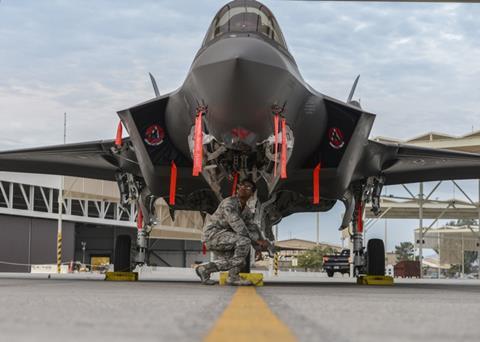US lawmakers unloaded anger against Lockheed Martin, Pratt & Whitney and the Department of Defense (DoD) during a 22 April hearing, criticising the group for not meeting F-35 stealth fighter programme sustainment goals.
“I’m [going to] take a deep breath and try to contain my anger at what is going on here,” said John Garamendi, chairman of the House Armed Services Subcommittee on Readiness. “The programme is over budget. It fails to deliver on promised capabilities. And, its mission capability rates do not even begin to meet the service’s thresholds.”

Garamendi and Donald Norcross, chairman of the House Armed Services Subcommittee on Tactical Air and Land Forces, were especially incensed with P&W F135 engine problems that threaten to take 43% of the USA’s total F-35 fleet out of action by 2030.
The stealth aircraft’s operating cost, estimated at $36,000 per flight hour, as well as delays and cost overruns for upgrade efforts, also drew fire.
“We don’t have unlimited resources as we chase this elusive affordability of the programme,” says Norcross. “Given the overall affordability concerns that exist within the programme, I would not support any request for additional aircraft beyond what is continued in this year’s president’s budget request.”
The hearing was jointly held by the two House Armed Services subcommittees.
Garamendi notes that the F-35 is the most expensive programme in the history of the DoD and that its sustainment costs are expected to exceed more than $1.2 trillion over the life of the programme.
In fiscal year 2020, the US Air Force’s F-35A full-mission capable rate was 54%, well shy of its 72% objective, according to a Government Accountability Office (GAO) report released on 22 April.
A reckoning for the F-35 programme is coming, Garamendi says.
“It seems like the industry solution for many of these problems is to ask the taxpayer to throw money at the problem. That will not happen. The easy days of the past are over,” he says. “This issue must be resolved, and it’s going to be resolved in the work of this committee this year.”
Lawmakers reacted to a revelation, disclosed in the GAO report, that the F135 engine had repair problems that could ground 43% of the US F-35 fleet – or about 800 aircraft – by 2030. An engine repair backlog is already impacting the F-35, with 20 aircraft unable to fly at the end of 2020.
Two main factors caused those engine issues, says GAO.
“First, F-35 squadrons removed engines for unscheduled maintenance more often than expected, primarily to repair the power module – a key component of the engine that generates thrust for the aircraft to fly,” the government watchdog says.
It notes that the F-35 Joint Program Office anticipated removing 52 power modules in 2020, but that 67 were actually removed.
“Second, the F-35 programme was able to repair only 43% of removed power modules in 2020, thereby resulting in a backlog of power modules needing repair,” the GAO report adds.
The F-35’s power module includes a compressor, combustor and two turbines. “It is considered the hottest part of the engine with the smallest rotational parts and some of the tightest tolerances,” says the report. It does not specify the exact nature of power module problems.
The DoD has struggled to keep up with repairs due to a lack of depot repair capacity and proficiency. The Pentagon is moving to increase its depot repair capacity for the power module, says the GAO.































